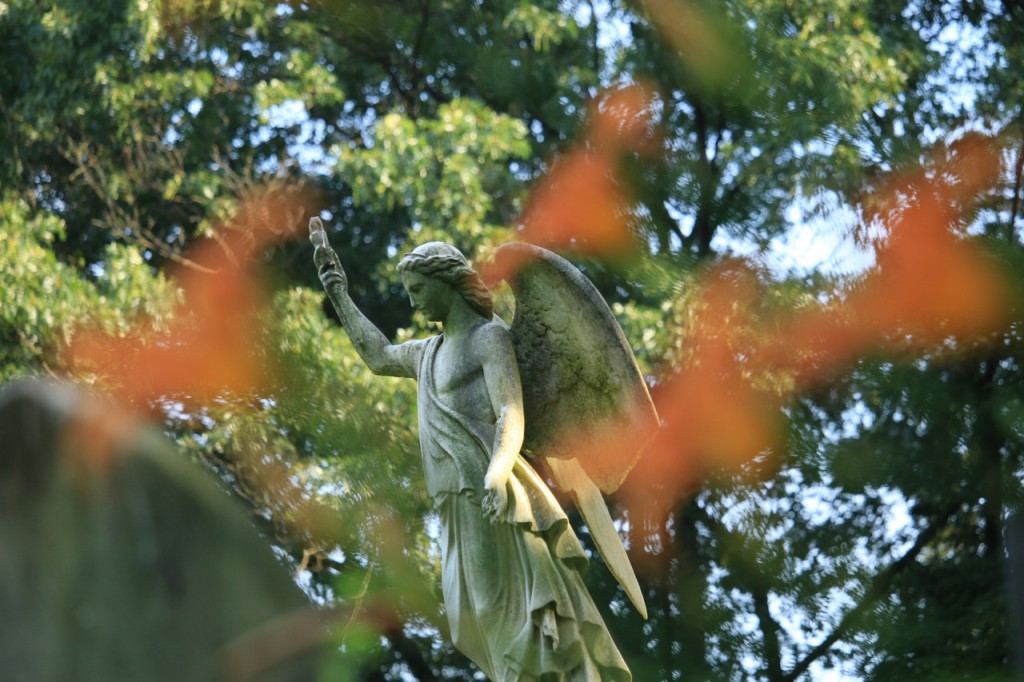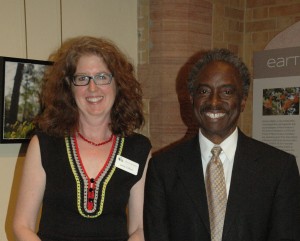Experiencing Roberto Mighty’s earth.sky

On a snowy February morning, I went to the studio of filmmaker and new media artist Roberto Mighty in Fort Point Channel to preview earth.sky, a multimedia installation that was to be shown at Story Chapel during Cambridge Open Studios weekend, May 9–10. I wasn’t sure quite what to expect. I had been working with Roberto for the past year on fundraising for his residency at Mount Auburn, making sure that he had the resources he needed to continue producing film and multimedia inspired by his time at the Cemetery. I had already seen several of the short films Mighty had created: each two- to five-minute piece focused on a person interred at Mount Auburn, using their own words and images of their monument in an emotionally and visually engaging way. Now I was curious to see how Mighty would pull the diverse subjects together into a single statement.
earth.sky, a multi-screen presentation 52 minutes in length, starts with the story of Peter Byus, a fugitive slave from Virginia who escaped to Massachusetts. His story is told using his will, a document that highlighted both the monumental injustice of slavery and the humanity of Byus: he wished to leave a bequest for his brother, who was still held in bondage in the South. Following Byus’s story, Mighty’s film showed Mount Auburn’s landscape in the winter. Music enhanced beautiful images of fast-falling snow as it swirled around Mount Auburn’s figural monuments.

Jenny Gilbert and Roberto Mighty
In earth.sky, the short narrative films are intercut with recurring motifs of the elements earth, air, fire, water, and sky. These “interludes” capture the stunning beauty of Mount Auburn. Whether we see snow piling up into the clasped hand of a monument, a Great Blue Heron taking flight over Auburn Lake, or the sound and sights of wind rushing through the landscape, the moments of beauty are ephemeral yet profound.
Mighty’s films also delve into more modern stories, using contemporary interviews to profile people more recently buried at Mount Auburn. Their stories are often as moving as those of historical figures. Mighty illuminates the diversity of individuals interred at the Cemetery and the impact—whether great or small—of their lives. He powerfully demonstrates the value of memorialization and memory in our society.
Roberto’s work does much to further Mount Auburn’s new mission to “inspire all who visit, comfort the bereaved, and commemorate the dead in a landscape of exceptional beauty.” Today, historic cemeteries have the dual purpose of serving the bereaved and acting as cultural institutions in their communities. In the nineteenth century, rural cemeteries were celebrated as visitor destinations and were well-known for their collections of art and horticultural specimens. In the early twentieth century, however, museums and public parks became the primary places where Americans explored art and communed with the natural world, and many cemeteries narrowed their focus, often becoming solely places to bury and commemorate the dead. But in the last decades of the twentieth century, Mount Auburn renewed its commitment to serving as a community resource and has become the national leader among historic cemeteries in its role as a cultural destination, educator, and steward.
In 2013, the Cemetery formed a trustee-level Education & Outreach Committee to help promote Mount Auburn’s role as a cultural resource. The committee’s goals include engaging new audiences while promoting the Cemetery as a thought leader. With these goals in mind, Mount Auburn has been working with artists and arts organizations to foster conversations with the public about mortality and the power of place. Recent programs in this vein have included last year’s staged readings of Thornton Wilder’s Our Town, in partnership with the Cambridge-based Underground Railway Theater; the third annual production of A Glimpse Beyond, a site-specific interpretation of Mount Auburn’s landscape through original music and choreography; and the highly successful series of Death Cafés. Mighty’s artist residency—the first of its kind—is yet another contribution to this effort.
The Friends of Mount Auburn Cemetery is still fundraising to support the completion of Mighty’s earth.sky project, which will be available as a GPS-tagged exhibition on Mount Auburn’s new mobile app slated to launch in 2017. Although the exhibition in Story Chapel was temporary, you can view an online preview of earth.sky on Mount Auburn’s website.
Leave a Reply